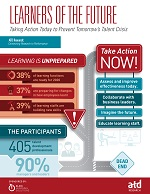ATD Blog
Using Social Media to Drive Social Learning
Fri Jan 15 2016

Bookmark
The ATD and i4cp study Instructional Design Now: A New Age of Learning and Beyond reported in early 2015 that social learning was in use by fewer than three in 10 organizations. However, another 46 percent of surveyed talent development professionals said they were considering social learning for future use or had it in development, suggesting significant anticipated growth.
Learners of the Future: Taking Action Today to Prevent Tomorrow’s Talent Crisis, the latest research study from ATD and i4cp notes that social media and other technologies provide a foundation for social learning, and asked about the L&D function’s role in encouraging learners to collaborate. Based on the top two responses, learning leaders view unfettered access to social media as an important aspect of the learning function’s contribution to that collaboration: 68 percent of respondents said that L&D should make access to social learning easy and fast and 60 percent advised removing barriers to social media’s effective use.
Enlisting the help of organizational influencers to model use of social technologies and involving users in designing learning opportunities also garnered responses of more than 50 percentage points. Here’s a look at the full results:
Make access to social learning easy and fast; 68%
Remove barriers (cultural, technological) to effective use of social media for learning; 60%
Enlist leaders or other influencers to model use of social technologies for learning; 53%
Involve users in designing engaging social learning opportunities; 51%
Include social experience and capabilities in competency models; 50%
Include social experience and capabilities in job descriptions; 48%
Provide motivation for learners to sign in to social media; 46%
Provide regular instruction so that all employees understand how to use social media effectively for learning (how to access media, share documents, make content searchable); 45%
Include social experience and capabilities in applicant screening; 45%
Track and report on social media technology use for learning; 41%
Reward learners for sharing with others on social media technologies; 41%
Make participation in social learning a formal job expectation for employees; 30%.
Without question, providing unhampered access to social media and other social technologies for employees certainly is a logical and undeniably supportive facet of enabling social learning in the virtual environment. However, correlation analysis uncovered several strategies with strong relationships to all three indices used in the Study, but none were related to access.
The strongest correlation with market performance was associated with involving users in designing engaging social learning opportunities, while highest correlations to both learning effectiveness and learning’s future readiness were found with including collaboration experience and capabilities in job descriptions. Motivating learners to sign in to social media and making social learning a formal job expectation showed significant correlations to all three indices as well.
So, while access is important, encouraging hands-on learner participation and establishing collaboration as a job expectation are more likely to help learning leaders move the needle on both organizational and L&D performance.
**
How Organizations Are Expanding Social Learning
**
Anecdotal evidence suggests that social learning is more likely to be under way in high-tech firms, and AT&T is no exception. “We are standing up what we call a personal learning environment or personal learning portal,” says Amy Rouse, a director at AT&T University. “This is literally one-stop shopping for everything you might need as a learner in a corporation. Part of it is up now, and the bulk of it should be completed next year.”
She notes that the environment includes “social learning communities of practice that are tied to courses, along with formal and informal learning events. Shortly we’ll have our career intelligence tied into it, too. That will enable employees to see where they are now and where they want to go in their current career paths. If they want to get into something different, it will note the competencies they need to make that change and the learning courses mapped to those competencies. That’s all built into this personal learning portal, which also enables employees to earn badges as they complete specific learning tracks.”
Employees at the Gates Foundation use Yammer internally, although Kara Laverde, manager of learning and development, reports mixed results in terms of learning success. Still, she says, “a lot of learning happens collaboratively. We’re going to experiment with tying it more closely to assignments for a course and see if that helps people get used to the technology and to working that way.”
Laverde sees the approach expanding in coming years, commenting that “I think anything that’s becoming a habit or an expectation in our personal lives will carry over into the workplace. And social media is now how people curate their news. There is more potential there for learning, and it will be interesting to see how we can leverage that.”
**
Social Technologies Present Challenges
**
Government agencies and many other organizations acknowledge the widespread use of social media in employees’ private lives and the promise offered by social learning. However, some organizational environments are more hospitable than others to the growth and utilization of social approaches.
The FAA’s Mary Susan Sparlin sees social learning lagging within the public sector. “I think its evolution in government organizations is going to be really slow,” she says. “Because when you talk social media, security has to be a big consideration, and it’s one that is difficult to resolve. Even in commercial companies I think you’re going to have that same problem. Companies that I interact with in the aircraft industry just don’t do social media learning.”
Even when social media is in use for collaboration, which is the case at PYXERA Global, Laura Asiala observes that parameters must be established and clearly communicated. “We use Twitter extensively,” she says. “We also use WhatsApp as kind of a group learning application. But one of the things we include in our prework with our corporate clients is a communications module. People need to understand what they are allowed to do—and not do. We’re able to provide a framework that our clients tend to be happy with. Working together with our clients, we can draw strict parameters, and we train people on that. People are not free to simply say anything about anything on social media with regard to the work and their projects.”

For more insights, check out Learners of the Future: Taking Action Today to Prevent Tomorrow’s Talent Crisis.
More from ATD
